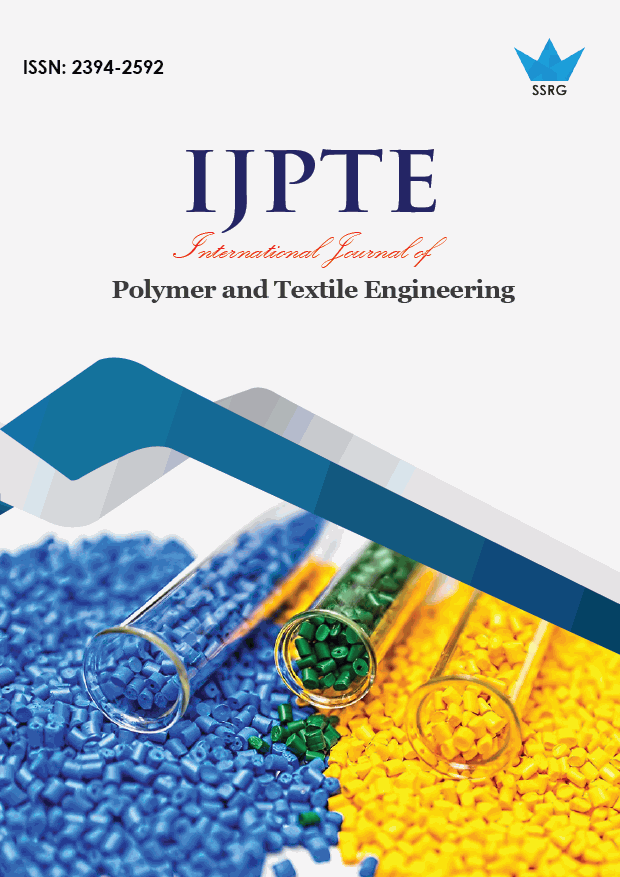Dyeing of Silk Fabric with Reactive Dye using Polyacrylamide as Exhausting Agent

| International Journal of Polymer and Textile Engineering |
| © 2020 by SSRG - IJPTE Journal |
| Volume 7 Issue 1 |
| Year of Publication : 2020 |
| Authors : Syed Atiqur Rahman |
How to Cite?
Syed Atiqur Rahman, "Dyeing of Silk Fabric with Reactive Dye using Polyacrylamide as Exhausting Agent," SSRG International Journal of Polymer and Textile Engineering, vol. 7, no. 1, pp. 1-5, 2020. Crossref, https://doi.org/10.14445/23942592/IJPTE-V7I1P101
Abstract:
In this study, Mulberry silk fabric samples were successfully dyed with reactive dye for 0.5, 1, 2, 3 and 4 shade% using polyacrylamide as exhausting
agent. Same Mulberry silk fabric samples were dyed with same reactive dye for same shade% using common salt as exhausting agent. Comparison
between fabric samples of corresponding shade% showed that the samples dyed with polyacrylamide exhaustion method are slightly lighter in color.
Washing and rubbing fastness tests showed that the fastness of both type of samples are very good and they are quite comparable to each other.
Keywords:
Silk Fabric, Reactive Dye, Polyacrylamide, Common salt, Spectrophotometry, Color Fastness
References:
[1] I. A. Bello, A.-R.A. Giwa, A. A. Olajire, and M. A. Oladipo, “Correlation between thermodynamic parameters and % exhaustions of some carboxylated reactive dyes on silk,” Chemistry and Materials Research, vol. 3, no. 9, 2013, pp. 1-5.
[2] D. Agarwal, K. Sen, and M. L. Gulrajani, 1996. “Application of heterobifunctional reactive dyes on silk,” Coloration Technology, vol. 112, 1996, pp. 10-16., doi:10.1111/j.1478-4408.1996.tb01748.x.
[3] D. Agarwal, K. Sen, and M. L. Gulrajani, “Dyeing of silk with bifunctional reactive dyes: the relationship between exhaustion and fixation,” Coloration Technology, vol. 113, 1997, pp. 174-178., doi:10.1111/j.1478-4408.1997.tb01893.x.
[4] P. G. H. Barker and A. Johnson, “The application of monochlorotriazinyl reactive dyes to silk,” Coloration Technology, vol. 89, 1973, pp. 203-208., doi:10.1111/j.1478-4408.1973.tb03148.x.
[5] S. M. Burkinshaw and M. Paraskevas, “The dyeing of silk: Part 3 the application and wash-off of modified vinyl sulfone dyes,” Dyes and Pigments, vol. 88, 2011, pp. 212-219., doi:10.1016/j.dyepig.2010.06.010.
[6] S. M. Burkinshaw and M. Paraskevas, “The dyeing of silk: Part 4 heterobifunctional dyes,” Dyes and Pigments, vol. 88, 2011, pp. 396-402., doi:10.1016/j.dyepig.2010.08.018.
[7] D. M. Lewis, “Developments in the chemistry of reactive dyes and their application processes,” Coloration Technology, vol. 130, no. 6, 2014, pp. 382-412., doi:10.1111/cote.12114.
[8] R. Rehman, S. Mahmud, M. A. Habib and A. Islam, “A revolution of silk dyeing with FL based cotton- reactive dyes,” International Journal of Textile Science, vol. 4, no. 2, 2015, pp. 42-52., doi: 10.5923/j.textile.20150402.03.
[9] G. E. Evans, J. Shore, and C. V. Stead, “Dyeing behavior of cotton after pretreatment with reactive quaternary compounds,” Coloration Technology, vol. 100, 1984, pp. 304-315., doi:10.1111/j.1478-4408.1984.tb00946.x.
[10] P. J. Hauser and A. H. Tabba, “Improving the environmental and economic aspects of cotton dyeing using a cationised cotton,” Coloration Technology, vol. 117, 2001, pp. 282-288., doi:10.1111/j.1478-4408.2001.tb00076.x.
[11] Y. A. Youssef, “Direct dyeing of cotton fabrics pre-treated with cationising agents,” Coloration Technology, vol. 116, no. 10, 2006, pp. 316-322., doi:10.1111/j.1478-4408.2000.tb00008.x.
[12] X. P. Lei and D. M. Lewis. “Modification of cotton to improve its dyeability. Part3 – polyamide-epichlorohydrin resins and their ethylenediamine reaction products,” Coloration Technology, vol. 106, 1990, pp. 352-356., doi:10.1111/j.1478-4408.1990.tb01231.x.
[13] M. N. Micheal, F. M. Tera, and S. F. Ibrahim, “Effect of chemical modification of cotton fabrics on dyeing properties,” Journal of Applied Polymer Science, vol. 85, 2002, pp. 1897-1903., doi:10.1002/app.10740.
[14] T. S. Wu and K. M. Chen, “New cationic agents for improving the dyeability of cellulose fibres. Part 2-pretreating cotton with polyepichlorohydrin-amine polymers for improving dyeability with reactive dyes,” J. Soc. Dyers Colourists, vol. 109, 1993, pp. 153-158., doi:10.1111/j.1478 4408.1993.tb01547.x.
[15] R. Nithyanandan and M. S. S. Kannan, “Salt & alkali free reactive dyeing on cotton,” Fibre2fashion.com, 2007, https://www.fibre2fashion.com/industry-article/1661/salt--alkali-free-reactive.
[16] S. A. Rahman, A.B.M. Foisal, and A. Sarker, “Treatment of cotton fabric with cationic polyacrylamide – an initiative to salt free reactive dyeing,” SEU Journal of Science and Engineering, vol. 9, no. 1-2, 2015, pp. 18-22.

 10.14445/23942592/IJPTE-V7I1P101
10.14445/23942592/IJPTE-V7I1P101